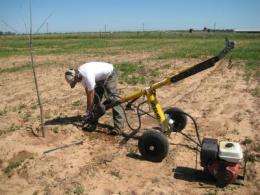Getting to the root of science in a nutty way

Dr. Leo Lombardini has gone underground to get the most top secret information in his field.
Lombardini is watching roots grow in his experimental orchards, and it is sort of nuts - he's a pecan researcher.
His study is part of a national specialty crop research project funded by the U.S. Department of Agriculture. Lombardini, a Texas AgriLife Research horticultural scientist, will focus on pecans while researchers at other universities focus on almonds, pistachios and walnuts. The overall goal is to discover ways to produce a higher quality, more nutritious nut in the most efficient, sustainable way.
"There have been very little root research efforts," said Lombardini who is teamed on the project with Dr. Astrid Volder, Texas A&M University assistant professor of horticultural sciences. "And there has been nothing that looks directly at the root. As far as we know, this is the first research to look at roots in the real setting."
To do that, Lombardini bored a hole at a 45-degree angle about 20 inches from the trunk of 20 trees in a 400-tree orchard planted in February. Each hole was fitted with a six-foot clear plastic tube into which a camera will be inserted at various times in the growing year.
"Pecan trees are planted bare root, that is with not much root system," Lombardini said. "The camera turns to capture a panoramic-type view. So we will be able to watch as these roots grow and see how they respond to various conditions over time."
A pecan tree spends its first five or six years growing into a mature tree capable of producing nuts. Spring is typically a period of growth for the trees, but it is not currently known whether first-year roots grow much in the first few months of planting. Lombardini hopes the initial shots from the camera in June will give an indication of first-year root growth.
"If we can see when various roots of a tree die or what happens to roots in a drought, for example, we then might know better how to schedule tree maintenance or apply nitrogen at the best time for the best results," Lombardini explained.
Lombardini plans to photograph the roots at least twice a year. A similar study in Las Cruces, N.M., will replicate his work, and the two can be compared.
The federal grant will provide $100,000 over three years for Lombardini's study.
Source: Texas A&M AgriLife Communications


















